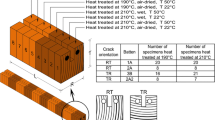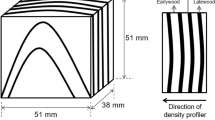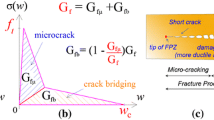Abstract
The fracture toughness of thermally modified beech (Fagus sylvatica L) and ash (Fraxinus excelsior L) wood under Mode I loading was quantified using Compact Tension (CT) specimens, loaded under steady-state crack propagation conditions. The influence of three heat-treatment levels and three moisture contents, as well as two crack propagation systems (RL and TL) was studied. Complete load–displacement records were analysed, and the initial slope, k init, critical stress intensity factor, K Ic, and specific fracture energy, G f, evaluated. In the case of both species, thermal modification was found to be significantly affect the material behaviour; the more severe the thermal treatment, the lower the values of K Ic and G f, with less difference being observed between the most severe treatments. Moisture content was also found to influence fracture toughness, but had a much less significant effect than the heat treatment.









Similar content being viewed by others
References
Aicher S, Reinhardt HW (1993) Influence of structure size in linear and nonlinear (wood) fracture mechanics. Holz Roh- Werkst 51:215–220
Beery WH, Ifju G, McLain TE (1983) Quantitative wood anatomy—relating anatomy to transverse tensile strength. Wood Fiber Sci 15(4):395–407
Bekhta P, Niemz P (2003) Effect of high temperature on the change in color, dimensional stability and mechanical properties of spruce wood. Holzforschung 57(5):539–546
Boatright SWJ, Garrett GG (1983) The effect of microstructure and stress state on the fracture behaviour of wood. J Mater Sci 18(7):2181–2199
Borrega M, Kärenlampi PP (2008) Mechanical behavior of heat-treated spruce (Picea abies) wood at constant moisture content and ambient humidity. Holz Roh Werkst 66:63–69
Boström L (1992) Method for determination of the softening behaviour of wood and the applicability of a nonlinear fracture mechanics model. In: Proceedings of the first European conference on wood modification. Lund, Sweden, pp 132
Burgert I, Eckstein D (2001) The tensile strength of isolated wood rays of beech (Fagus sylvatica L.) and its significance for the biomechanics of living trees. Trees 15:168–170
Ehart RJA, Stanzl-Tschegg SE, Tschegg EK (1996) Characterization of crack propagation in particleboard. Wood Sci Technol 30(5):307–321
Esteves B, Velez Marques A, Domingos I, Pereira H (2007) Influence of steam heating on the properties of pine (Pinus pinaster) and eucalypt (Eucalyptus globulus) wood. Wood Sci Technol 41:193–207
Esteves B, Velez Marques A, Domingos I, Pereira H (2008) Heat-induced colour changes of pine (Pinus pinaster) and eucalypt (Eucalyptus globulus) wood. Wood Sci Technol 42:369–384
Fengel D, Wegener G (1989) Wood: chemistry, ultrastructure, reactions. New York
Frühmann K, Burgert I, Stanzl-Tschegg SE, Tschegg EK (2003) Mode I fracture behaviour on the growth ring scale and cellular level of spruce (Picea abies [L.] Karst.) and beech (Fagus sylvatica L.) loaded in the TR crack propagation system. Holzforschung 57(6):653–660
Gustafsson PJ (1988) A study of strength of notched beams. In: Proceedings, CIB-W18, Meeting 21. Vancouver
Gustafsson PJ (1992) Fracture mechanics in codes of timber design. In: COST 508—Wood mechanics workshop on fracture mechanics in wooden materials
Harmuth H, Rieder K, Tschegg E, Krobath M (1996) Investigation of the nonlinear fracture behaviour of ordinary ceramic refractory materials. Mater Sci Eng A214:53–61
Jeronimidis G (1980) The fracture behaviour of wood and the relations between toughness and morphology. Proc R Soc Lond B 208:447–460
Johansson D, Morén T (2006) The potential of colour measurement for strength prediction of thermally treated wood. Holz Roh- Werkst 64:104–110
Kamdem DP, Pizzi A, Jermannaud A (2002) Durability of heat-treated wood. Holz Roh- Werkst 60:1–6
King MJ, Sutherland IJ, Le-Ngoc L (1999) Fracture toughness of wet and dry Pinus radiata. Holz Roh- Werkst 57(4):235–240
Kocaefe D, Shi JL, Yang DQ, Bouazara M (2008) Mechanical properties, dimensional stability, and mold resistance of heat-treated jack pine and aspen. For Prod J 58(6):88–93
Kretschmann DE, Green DW (1996) Modeling moisture content-mechanical property relationships for clear southern pine. Wood Fiber Sci 28(3):320–337
Kubojima Y, Okano T, Ohta M (2000) Bending strength and toughness of heat-treated wood. J Wood Sci 46:8–15
Mitteramskogler GMBH (2007) Optimised thermal treatment parameters with respect to mechanical properties. Deliverable D8 from the European project NO. NMP2-CT-2005-011799. Project acronym, HOLIWOOD, pp 45
Patzelt M, Emsenhuber G, Stingl R (2003) Colour measurements as means of quality control of thermally treated wood. In: Proceedings of the first European conference on wood modification. Ghent, Belgium. April 3–4 2003, pp 213–218
Poncsák S, Kocaefe D, Bouazara M, Pichette A (2006) Effect of high temperature treatment on the mechanical properties of birch (Betula papyrifera). Wood Sci Technol 40(8):647–663
Prokopski G (1996) Influence of moisture content on fracture toughness of wood. Int J Fract 79:R73–R77
Reiterer A, Sinn G (2002) Fracture behaviour of modified Spruce wood: a study using linear and non linear fracture mechanics. Holzforschung 56:191–198
Reiterer A, Tschegg G (2002) The influence of moisture content on the mode I fracture behaviour of sprucewood. J Mater Sci 37:4487–4491
Reiterer A, Burgert I, Sinn G, Tschegg S (2002a) The radial reinforcement of the wood structure and its implication on mechanical and fracture mechanical properties—A comparison between two tree species. J Mater Sci 37:935–940
Reiterer A, Sinn G, Stanzl-Tschegg SE (2002b) Fracture characteristics of different wood species under mode I loading perpendicular to the grain. Mater Sci Eng A332:29–36
Rowell RM (1999) Specialty treatments. In: Wood handbook-wood as an engineering material. Forest Products Laboratory, Madison, pp 19.1–19.14
Samarasinghe S, Kulasiri GD (2000) Displacement fields on wood in tension based on image processing: part 2. Crack-tip displacements in mode-I and mixed-mode fracture. Silva Fenn 34(3):261–274
Santos JA (2000) Mechanical behaviour of Eucalyptus wood modified by heat. Wood Sci Technol 34:39–43
Schachner H, Reiterer A, Stanzl-Tschegg SE (2000) Orthotropic fracture toughness of wood. J Mater Sci Lett 19:1783–1785
Schneider A (1971) Investigations on the influence of heat treatments within a range of temperature from 100°C to 200°C on the modulus of elasticity, maximum crushing strength, and impact work of Pine sapwood and Beechwood. Holzforschung 29:431–440
Shi JL, Kocaefe D, Zhang J (2007) Mechanical behaviour of Québec wood species heat-treated using Thermo wood process. Holz Roh- Werkst 65:255–259
Sippola M, Koponen S (1999) Fracture behaviour of clear softwood—tests and FEM models. In: COST-Action E8: 207–221
Smith I, Chui YH (1994) Factors affecting mode I fracture energy of plantation-grown red pine. Wood Sci Technol 28:147–157
Stanzl-Tschegg SE (2006) Microstructure and fracture mechanical response of wood. Int J Fract 139:495–508
Stanzl-Tschegg SE, Tan DM, Tschegg EK (1995) New splitting method for wood fracture characterization. Wood Sci Technol 29:31–50
Sundqvist B (2004) Colour changes and acid formation in wood during heating. PhD thesis. Lulea University of Technology, Sweden
Sundqvist B, Morén T (2002) The influence of wood polymers and extractives on wood colour induced by hydrothermal treatment. Holz Roh- Werkst 60(5):375–376
Tjeerdsma BF, Boonstra M, Pizzi A, Tekely P, Militz H (1998) Characterisation of thermally modified wood: molecular reasons for wood performance improvement. Holz Roh- Werkst 56:149–153
Tjeerdsma BF, Kattenbroek B, Jorissen A (2007) Acetylated wood in exterior and heavy load-bearing constructions: building of two timber traffic bridges of acetylated Radiata pine. In: Hill CAS, Jones D, Militz H, Ormondroyd GA (Eds) Proceedings of the 3rd European conference on wood modification, 15–16th October 2007. Cardiff, UK, pp 403–411
Tschegg EK (1986) Equipment and appropriate specimen shape for tests to measure fracture values. Patent AT-390328
Tschegg EK, Elser M, Kreuzer H (1995) Mode I fracture behaviour of concrete under biaxial loading. J Mater Sci 30(1):235–242
Tschegg EK, Frühmann K, Stanzl-Tschegg SE (2001) Damage and fracture mechanisms during mode I and III loading of wood. Holzforschung 55:525–533
Tukiainen P, Koponen S (2006) Fracture behaviour of small wood specimens in RT-direction. In: Proceedings of the 10th world conference on timber engineering. Portland, OR, USA, pp 55
Valentin GH, Boström L, Gustafsson PJ, Ranta-Maunus A, Gowda S (1991) Application of fracture mechanics to timber structures RILEM state-of-art report. VTT Technical Research Centre of Finland. Research notes 1262
Vasic S, Smith I (1996) The brittleness of wood in tension perpendicular to the grain: micro-mechanical aspects. In: Proceedings of COST 508 wood mechanics conference. Stuttgart, Germany, 1996, May 14–16, pp 555–569
Vasic S, Stanzl-Tschegg S (2007) Experimental and numerical investigations of wood fracture mechanisms at different humidity levels. Holzforschung 61:367–374
Wang LY, Lu ZY, Zhao GJ (2003) Wood fracture pattern during the water adsorption process. Holzforschung 57:639–643
Yildiz UC, Yildiz S (2005) Mechanical and chemical behavior of beech wood modified by heat. Wood Fiber Sci 37(3):456–461
Yildiz S, Çolakoglu G, Yildiz ÜC, Gezer ED, Temiz A (2002) Effects of heat treatment on modulus of elasticity of beech wood. IRG/WP 02-40222
Zaman A, Alen R, Kotilainen R (2000) Thermal behavior of scots pine (Pinus Silvestrys) and silver birch (Betula Pendula) at 200–230°C. Wood Fiber Sci 32(2):138–143
Zhao G, Jiao H, Xu S (1991) Study on fracture behaviour with wedge splitting test method. In: JGMv Mier, JG Rots, E Bakker, FN Spon (Eds) RILEM Fracture processes in concrete, rock and ceramics
Acknowledgments
The results presented were developed within the IP-SME project HOLIWOOD (Holistic implementation of European thermally treated hard wood in the sector of construction industry and noise protection by sustainable, knowledge-based and value added products). This Project is carried out with the financial support from the European Community within the Sixth Framework Program (NMP2-CT-2005-IP 011799-2). This publication reflects the authors view. The European Community is not liable for any use that may be made of the information contained therein. We would like also thank the staff of the Laboratory of Forest Products Technology, TKK, particularly to Pekka Tukiainen, for his support. Also thanks are due to the staff at the Institute for Systems based on Optoelectronics and Microtechnology, UPM, and in particular to David López-Romero Moraleda.
Author information
Authors and Affiliations
Corresponding author
Rights and permissions
About this article
Cite this article
Majano-Majano, A., Hughes, M. & Fernandez-Cabo, J.L. The fracture toughness and properties of thermally modified beech and ash at different moisture contents. Wood Sci Technol 46, 5–21 (2012). https://doi.org/10.1007/s00226-010-0389-4
Received:
Published:
Issue Date:
DOI: https://doi.org/10.1007/s00226-010-0389-4




